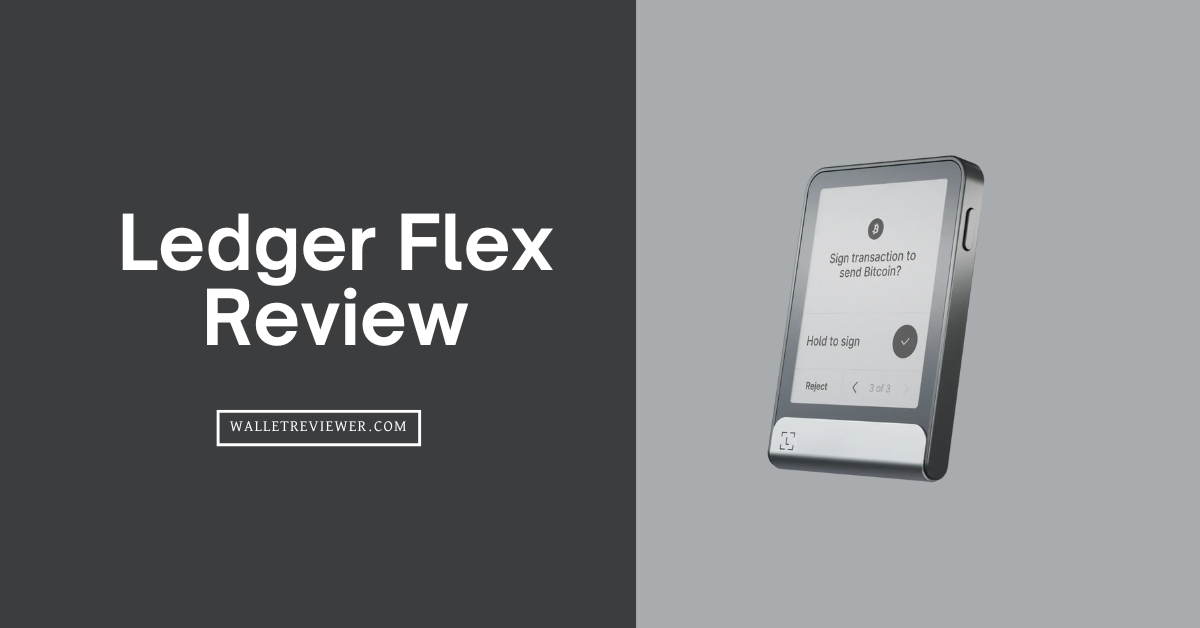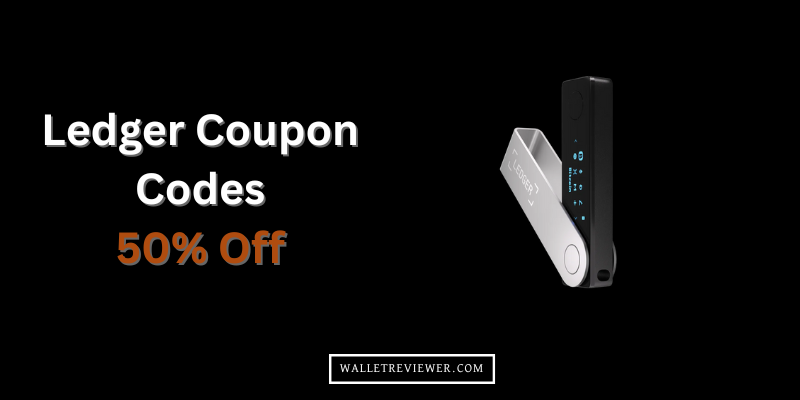Ledger Flex is not just another hardware wallet – it’s built for people who want serious security with modern features. I spent days testing it, comparing it with other top wallets, and going through every small detail.
This Ledger Flex review covers everything you actually need to know. From setup to daily use, the experience feels smooth and reliable. The Ledger Flex wallet supports over 15,000 crypto assets, including NFTs and staking options, which is impressive for a compact device like this.
Here is my in-depth Ledger Flex wallet review…
Ledger Flex Hardware Wallet Review (Quick Summary)
| Launch Date | July 26, 2024 (retail price USD 249) |
| Price (MSRP) | USD 249 |
| Display | 2.84‑inch E Ink touchscreen, 16‑gray levels, 600×480 px resolution |
| Security Element | Chip: ST33K1M5, certified CC EAL 6+ |
| Battery | 200 mAh rechargeable lithium‑ion battery; claimed weeks or months of standby |
| Weight & Dimensions | 57.5 g; 78.4 × 56.5 × 7.7 mm |
| Connectivity | USB‑C, Bluetooth 5.2, NFC support |
| Storage Capacity | ~1.5 MB, supports many crypto‑apps (each ~70‑150 KB) |
| Supported Assets | 15,000+ cryptos & tokens via Ledger Live; Ethereum & Polygon NFTs; more via third‑party wallets |
| Companion Software | Works with Ledger Live (Desktop & Mobile) Buy, sell, swap, stake, portfolio, and NFTs |
| User Experience | Clear‑sign on secure display; customizable lock screen (image or NFT visible even in standby) |
| Security Features | Secure Element + Ledger OS; private keys offline; PIN protected; factory reset after three wrong PIN tries |
| Recovery Options | Uses standard 24‑word BIP‑39 recovery phrase Free Ledger recovery key (till August 30, 2025) |
| Additional Tools | Ledger Security Key app (FIDO2 passkey and 2FA login) |
Introduction to Ledger Flex
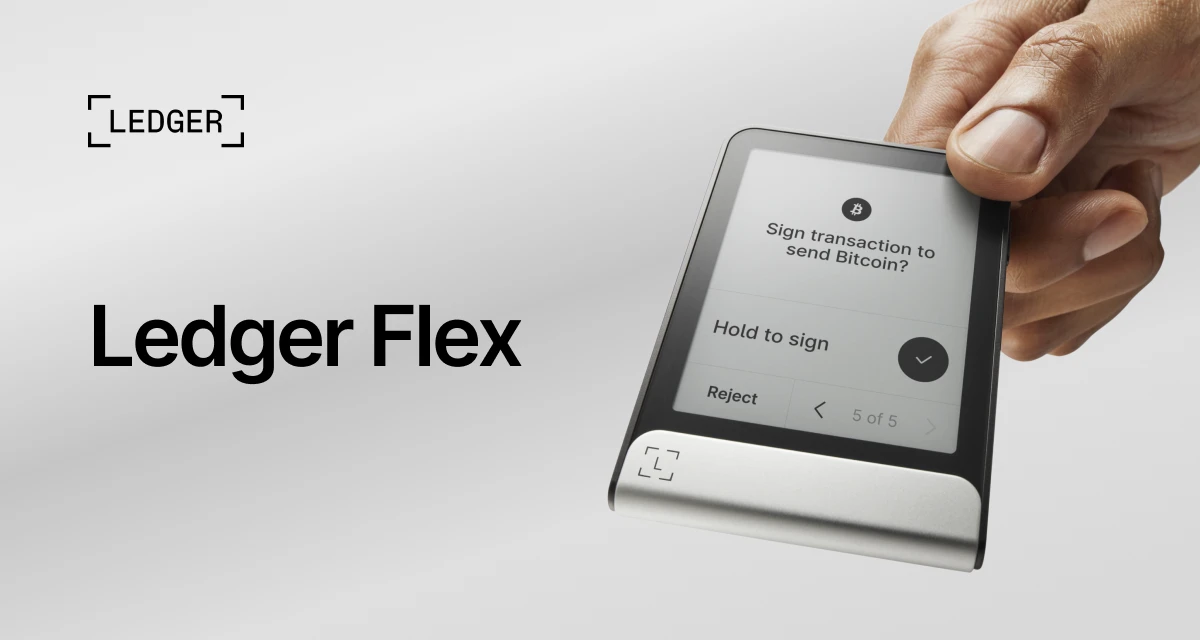
The Ledger Flex is a hardware wallet designed to securely store cryptocurrencies. It’s a compact device that focuses on ease of use with its E Ink touchscreen, similar to a Kindle. This screen allows you to clearly see and approve transactions directly on the device, which is a key security feature.
You connect the device to your smartphone or computer using Bluetooth or a USB-C cable, and you manage your crypto through the Ledger Live app. The app lets you buy, sell, swap, and stake various cryptocurrencies.
The Flex supports a wide range of digital assets, including over 15,000 coins and tokens. It also has features like a customizable lock screen where you can display your favorite images or NFTs. The device has a decent battery life and is built to be durable with an aluminum frame.
However, it’s worth noting that the screen is not backlit, so it can be hard to use in the dark without an external light. Some users have also reported occasional lag and Bluetooth connectivity issues with certain mobile devices. Despite these small points, the Ledger Flex offers a secure and user-friendly way to manage your cryptocurrency, especially if you value a clear visual interface for transactions. (Check my in-depth Ledger wallet review guide)
Ledger Flex + Ledger Recovery Key
The newest Ledger Recovery Key is a small, physical card that works like a smart backup for your Ledger Flex or Ledger Stax wallet. You need to simply tap the card on your device using NFC, and it transfers or restores your recovery secret safely.
You create a PIN on the card, and whenever you want to use it, you’ll need to enter both the card PIN and your Ledger device PIN. This double check makes sure that only you can use the card with your wallet. It’s a smart way to avoid mistakes or unauthorized access.
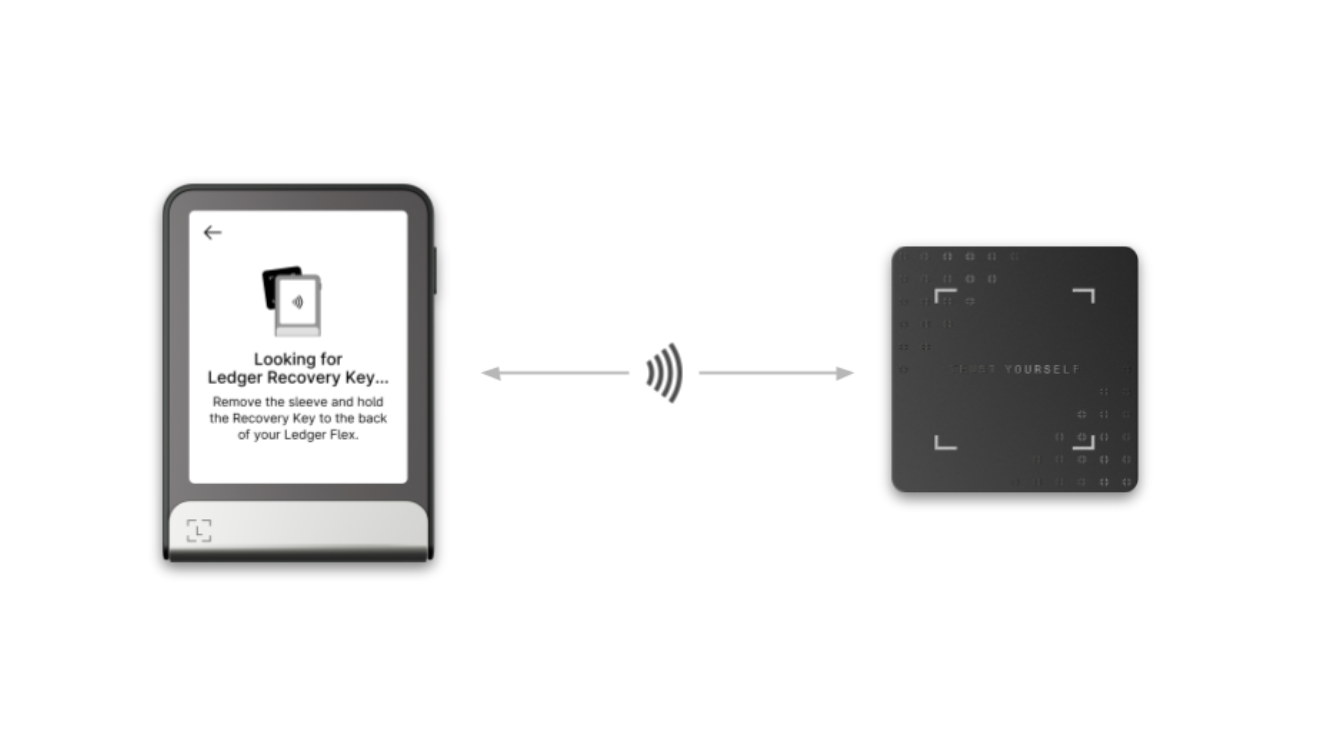
The best part? There’s no KYC, no identity verification, and no subscription involved. Everything stays offline, and nothing is stored on the cloud. If you’re someone who prefers full control of your crypto, this tool gives real peace of mind.
Ledger also made the software open-source and fully audited, so you know what’s happening behind the scenes. (Read the full guide about Ledger Recovery Key)
Note: Currently, you can get free LRK with a Ledger Flex.
Ledger Flex Review: Design & Build Quality
Ledger Flex has a compact and lightweight body, weighing just 57.5 grams, which makes it easy to carry around without feeling bulky. The dimensions are 78.4 x 56.5 x 7.7 mm, so it fits well in your hand and even in small pockets. It feels like a mix between a mini-tablet and a smart card, but much more secure.
The display is sharp, supports 16 levels of grayscale, and offers a 600 x 480 resolution. Even in sunlight or low light, the screen remains easy to read. It uses an always-on screen for displaying your custom image or NFT, even when the device is in standby mode.
The materials used feel durable, and the device gives a premium feel without being fragile. The buttonless, flat surface combined with touchscreen navigation makes everything smooth and modern.
Security Features of Ledger Flex: Is it Safe?
The Ledger Flex includes a top-grade Secure Element chip (ST33K1M5), which is certified CC EAL6+. This is the same kind of chip used in passports and banking systems. It protects your private keys by making sure they never leave the device, even when connected to your phone or computer.
It runs on Ledger’s custom OS (BOLOS), which creates a separate, secure environment for each crypto app installed. This isolation protects your assets in case one app gets compromised or misbehaves. The system also blocks unapproved access and ensures only verified operations can run.
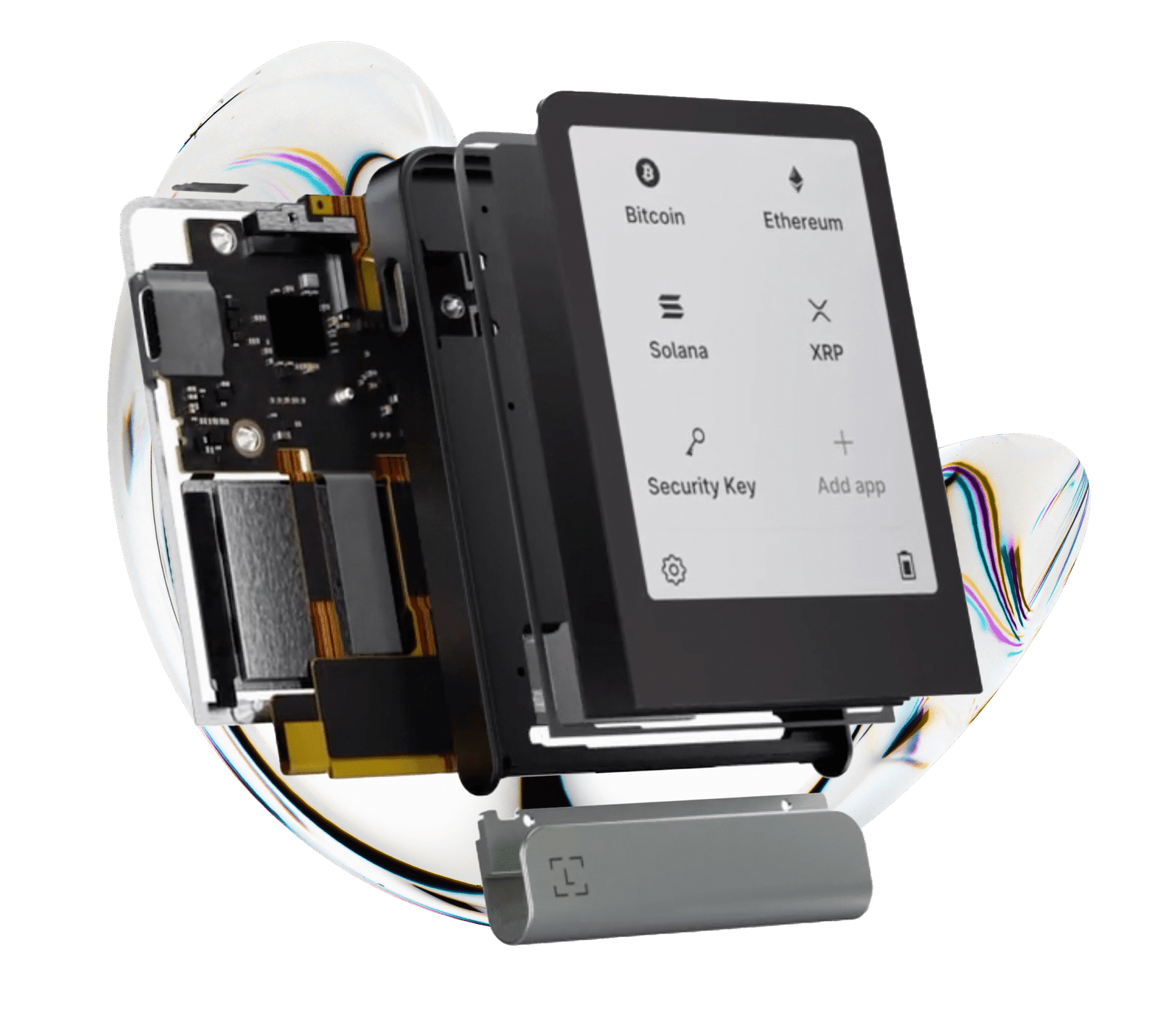
To prevent unauthorized access, Ledger Flex is protected with a PIN code system. If someone tries to guess your PIN and fails three times, the device automatically resets to factory settings. This way, your private keys are erased and cannot be recovered by anyone else.
Ledger Flex also supports BIP39 recovery phrases, using a 24-word seed to back up your wallet. This phrase can restore your assets if the device is lost or damaged. You also have the option to use Ledger Recover, a subscription-based backup service that stores your recovery phrase securely using ID verification.
Supported Assets and Ecosystem
Ledger Flex supports over 15,000 cryptocurrencies and tokens, as maintained by Ledger Live and third‑party integrations.
It works seamlessly with the Ledger Live app on desktop and mobile for managing assets, staking, swapping, or tracking your portfolio. If a particular token isn’t natively supported in Ledger Live, you can still use third-party wallets like MetaMask or Rabby to access up to 5,000+ additional coins and NFTs.
My Ledger Flex review shows that NFT compatibility covers Ethereum and Polygon networks, and third-party Web3 apps expand support even more.
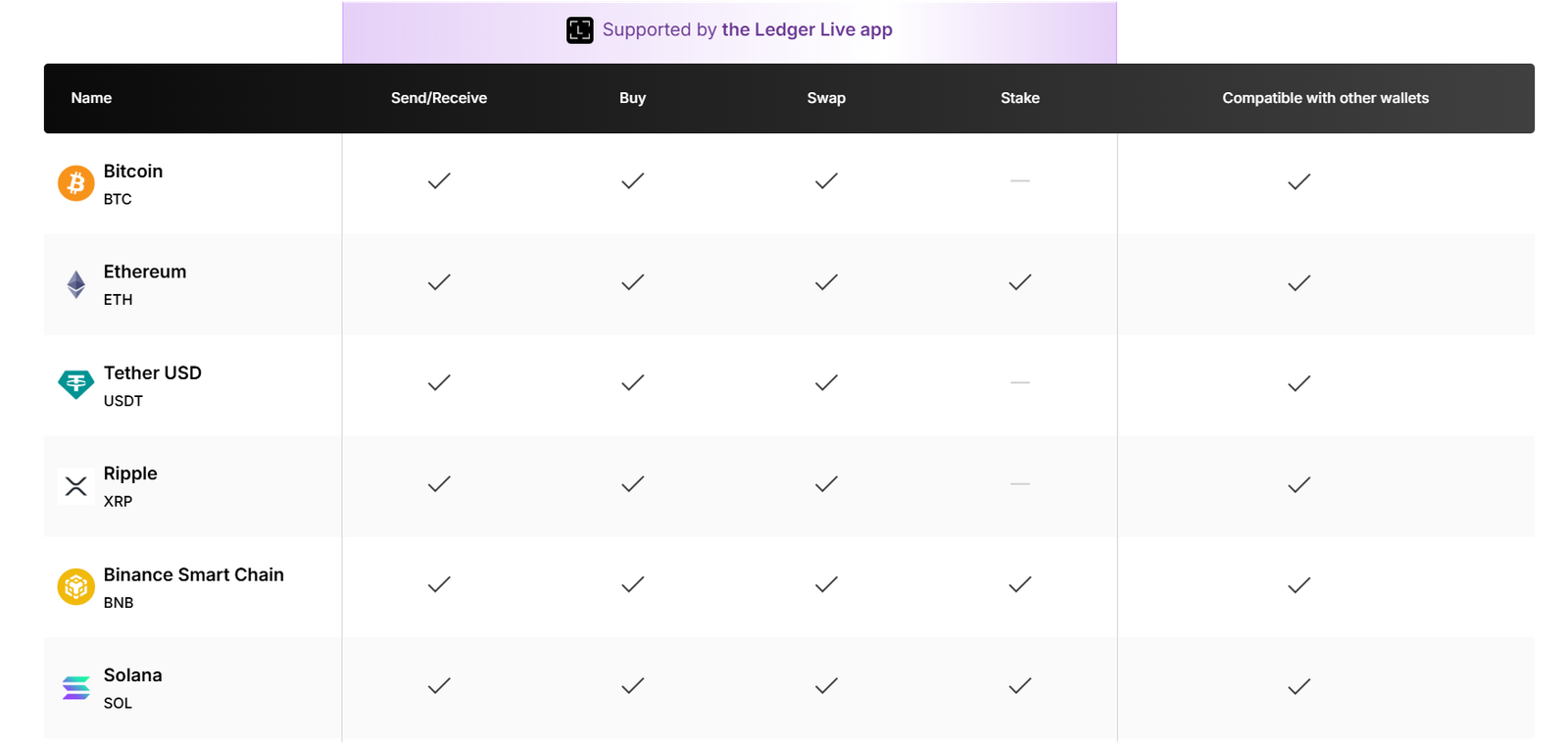
Ledger Flex Connectivity and Setup Review
The device features USB‑C, Bluetooth 5.2, and NFC connectivity options, giving you flexibility to pair it with your smartphone or desktop.
To set it up, you power it on and use the Ledger Live app, which guides you through naming your device, choosing a PIN (4‑8 digits), writing down your 24‑word recovery phrase, and confirming it step by step.
Once paired via Bluetooth or plugged in via USB‑C, the pairing codes appear, and you simply confirm they match for extra security.
After setup, you can install crypto apps on the 1.5 MB internal storage, and in my Ledger Flex review, I found that each app is sized around 70-150 KB, to support different assets.
User Experience and Interface
You will see a 2.84‑inch E Ink touchscreen with 16 levels of grayscale and 600×480 pixel resolution—sharp and readable even in bright light.
The interface is smooth with swipe and tap navigation, and every transaction or login request shows clear human‑readable details for approval, a feature Ledger calls Clear Signing.
You can also customize your lock screen with an image or NFT, displayed even when the device is idle. The experience feels modern and intuitive, almost like using a mini smart device, while always keeping private keys secure offline.
Read more: Ledger Flex vs Stax
Ledger Flex Review: Battery Life and Portability
Ledger Flex uses a 200 mAh rechargeable lithium‑ion battery, and thanks to its low‑power E Ink display, it can last weeks or even months in standby mode between charges.
In normal usage, such as occasional transactions or balance checks, you may only need to charge it once or twice a week. The device weighs just 57.5 g and measures 78.4 × 56.5 × 7.7 mm, making it ultra‑light and easy to carry in a pocket or small pouch. You’ll barely notice it in your daily routine.
Ledger Flex review: Pricing and Availability
Ledger Flex launched on July 26, 2024, with an official price of USD 249. It is available in multiple colors, including Graphite, BTC Orange, Neptune Blue, Oxidate Green, and in a Solana Edition, which includes Sol‑based perks like NFT tokens and voucher rewards.
You can purchase directly from Ledger’s official store, where occasional bundles are offered, such as the Solana bundle or Monopoly Bitcoin bundle.
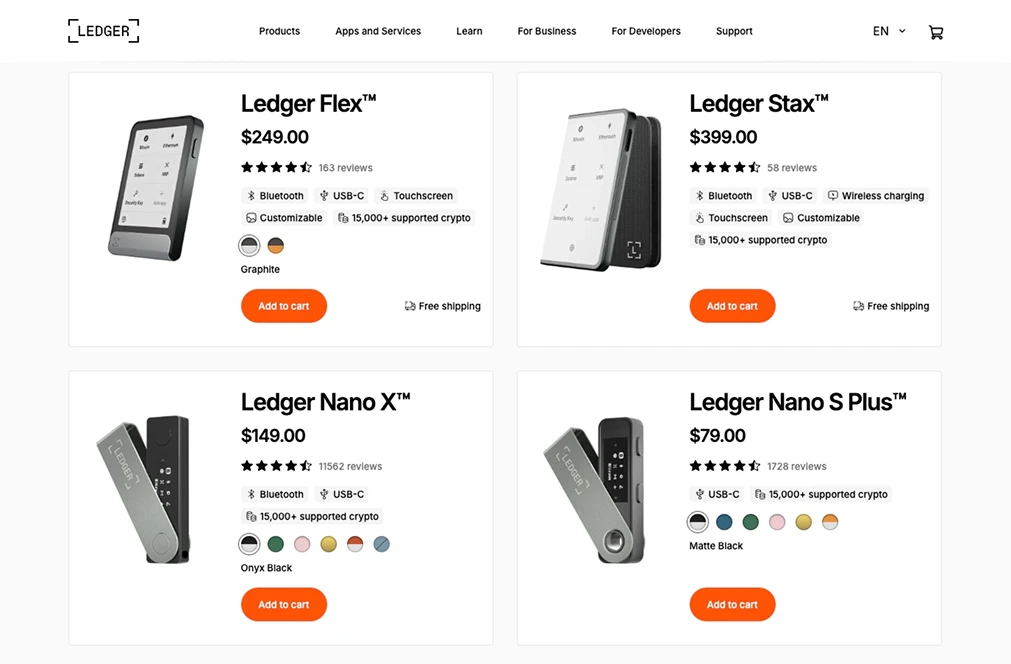
Drawbacks and Limitations of Ledger Flex
Poor visibility
Although the E Ink display on Ledger Flex looks sharp indoors, it struggles a little bit in dark and direct sunlight. If you try to use the device outside or near a bright window, you’ll likely notice glare or faded visibility on the screen.
This can make it hard to read your PIN or confirm transactions unless you angle the device just right. Unlike paper-like E Ink screens used in e-readers, this one doesn’t handle outdoor brightness as well as expected. If you travel a lot or often use your wallet outside, this can be an annoying limitation.
Touchscreen Responsiveness Issues (Lag or mis-taps during PIN entry)
Another common complaint is about the touchscreen’s responsiveness. During PIN entry or app navigation, the screen sometimes feels laggy or misses your taps.
This is partly because E Ink refreshes more slowly than traditional screens. If you tap too fast or press slightly off-target, it might not respond properly.
You may have to slow down or try again, which can be a bit frustrating, especially when you just want to approve something quickly and move on. It doesn’t ruin the experience, but it definitely slows things down at times.
Read more articles:
- Best crypto hardware wallets
- Best crypto wallets
- Best cold storage wallets for altcoins
- Ledger vs Trezor
- Best Bitcoin wallets
- Ledger Nano X review
- Ledger Stax review
FAQs: Ledger Flex Wallet Review
What is Ledger Flex and how does it work?
Ledger Flex is a premium crypto hardware wallet made for securely storing and managing Bitcoin and NFTs. It uses a certified Secure Element chip (EAL 6+) to keep your private keys completely offline.
It connects to your phone or desktop using USB-C, Bluetooth 5.2, or NFC. You use it with the Ledger Live app to send, receive, swap, or stake assets. Every action you take must be confirmed on the device’s screen, which prevents remote hacks.
Ledger Flex works like a physical vault for your crypto, combining high-level security with a modern, touchscreen experience.
Is Ledger Flex better than Ledger Stax?
Ledger Flex and Ledger Stax are both high-end wallets, but each suits different needs.
Flex is lighter, more compact, and includes NFC support. It’s also more affordable at $249 compared to Stax’s $399.
However, Stax has a curved glass E Ink screen and wireless charging, which Flex lacks. If you want portability, Flex is better. If you care about design and a bigger display, Stax might suit you more.
In terms of security and asset support, both are equal. It really comes down to personal preferences around design and day-to-day usage.
How secure is the Ledger Flex hardware wallet?
Ledger Flex is built for serious security. It uses a Secure Element chip (ST33K1M5) that’s certified at CC EAL6+, the same level used in biometric passports. Your private keys never leave the device and are isolated from your phone or computer.
If someone enters the wrong PIN three times, the device wipes itself. It also supports standard 24-word seed phrases and offers optional Ledger Recover and Recovery Key features for offline backups.
Every transaction must be confirmed on-screen using Clear Signing, so nothing happens without your approval. For cold storage, it’s one of the most secure crypto wallets available today.
Does Ledger Flex support staking?
Yes, Ledger Flex supports staking for several major coins directly through the Ledger Live app. You can stake assets like Ethereum, Solana, Polkadot, Cosmos, and Tezos without needing to move your crypto to an exchange. My Ledger Flex review finds that the rewards are deposited directly into your wallet, and you stay in full control of your funds.
Can I store NFTs on Ledger Flex?
Yes, you can store NFTs on Ledger Flex, but only those based on the Ethereum and Polygon networks.
You manage your NFTs through Ledger Live, where you can view, send, or receive them securely. Each NFT appears with its metadata and image, so you know exactly what you’re interacting with. You can also customize the lock screen with your favorite NFT.
How do I set up Ledger Flex with Ledger Live?
To set up Ledger Flex, first download the Ledger Live app on your desktop or mobile. Turn on your device, choose a PIN, and write down your 24-word recovery phrase.
Ledger Live will guide you step-by-step to pair the device using USB-C or Bluetooth. Once connected, you’ll install crypto apps like Bitcoin, Ethereum, etc., based on what coins you want to manage.
The app lets you buy, send, receive, stake, and view your portfolio. Every transaction must be confirmed on the Flex screen for security. The setup takes about 10–15 minutes and is beginner-friendly.
What cryptocurrencies are supported by Ledger Flex?
Ledger Flex supports over 15,000 crypto assets, including major coins like Bitcoin, Ethereum, USDT, BNB, Solana, XRP, and Cardano. These can be managed through the Ledger Live app.
For lesser-known or niche coins, you can use Flex with third-party wallets like MetaMask, Rabby, or Keplr. It also supports tokens across multiple blockchains like ERC-20, BEP-20, TRC-20, and more.
Is Ledger Flex worth the price?
At $249, Ledger Flex sits in the premium range of hardware wallets, but it offers a lot for the price.
You get top-tier security with a certified Secure Element chip, Bluetooth and NFC support, a responsive touchscreen, and access to over 15,000 cryptocurrencies. It also supports staking, NFTs, and Web3 logins using FIDO2. The design is lightweight, pocket-friendly, and looks sleek.
Can Ledger Flex be used on mobile and desktop?
Yes, Ledger Flex works on both mobile and desktop. You can connect it to your phone using Bluetooth 5.2 or USB-C, and it pairs easily with the Ledger Live app on Android and iOS.
For desktops, you can use USB-C to connect it to Windows, macOS, or Linux. Once connected, you’ll manage your coins, send and receive funds, stake, and view your NFT collection, all through Ledger Live.
